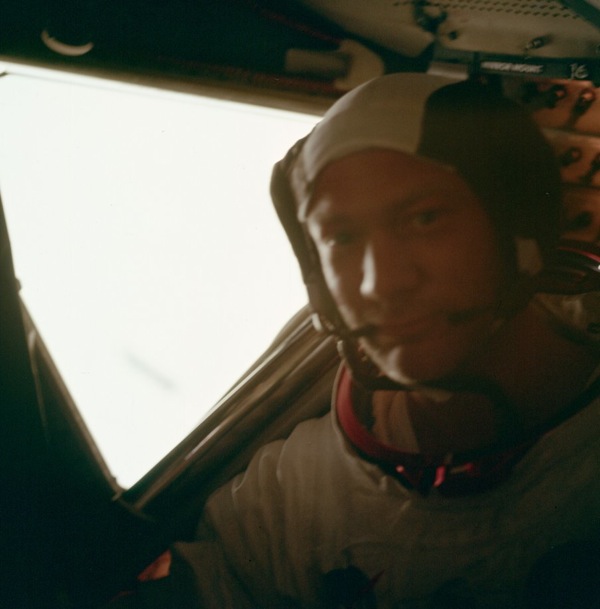40 Years after Apollo 11: July 20 - Landing Day!
Originally written on July 20th, 2009…
While working on this little chronicle, there have been days when I’ve really had to search to find pictures that were definitely from that day. Not so here. Around 300 pictures were taken on the surface of the Moon on this day 40 years ago. I’ll try to find a few of the less common ones.
But first, a note about the landing. It almost didn’t happen.
Neil and Buzz were heading for the surface, the lunar module’s rocket firing all the way, as there was no atmosphere to use to slow their decent. The rocket had to fire, and it had to fire all the way down. And that meant it was using fuel. And there was only so much room for fuel. That will become a problem in a minute.
Early in the decent, other problems were cropping up. The antenna, which was supposed to automatically point back to Earth, kept moving a little off the mark, causing the signal to drop out. Then Houston would have to call Mike in the command module and ask him to relay info to Neil and Buzz in the lunar module. Just when that problem was settling down…
“Program alarm!”
As you may know, the guidance computer in the lunar module was less powerful than an iPhone. How were they able to use something so primitive to do something so complex as land on the Moon? For one thing, the LM computer was only programmed to land on the Moon. It didn’t have a fancy graphic display, its user interface was a keypad with about as many keys as an ATM, and it could not be used to open a Word doc (not that any existed.) All it did was take input from the sensors on the LM and make small adjustments to the attitude and speed of the ship as it descended towards the Moon. 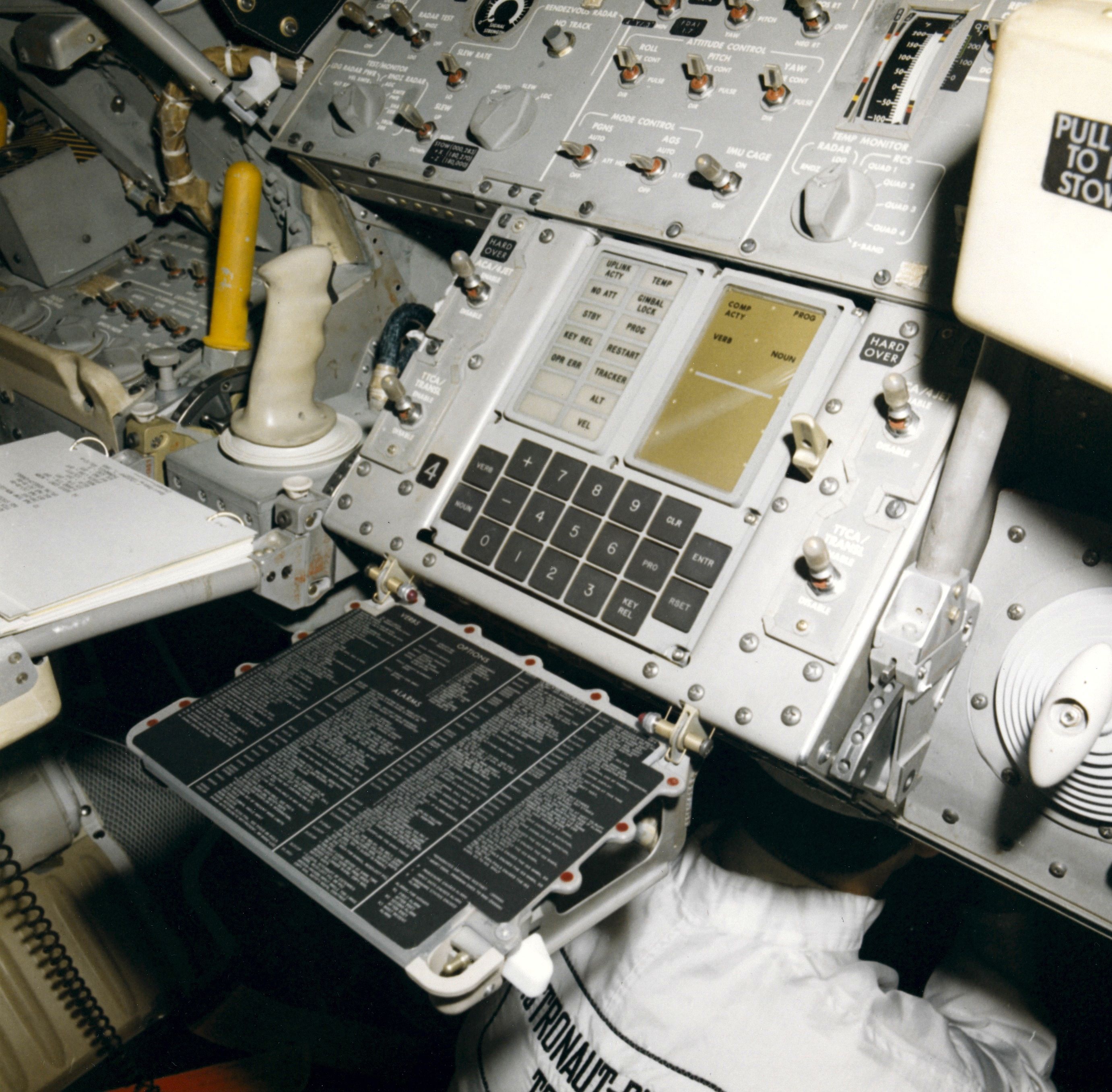
But now, suddenly, on the little pocket calculator-like display of the computer, Neil and Buzz saw “1202.” That may not seem ominous, but in the literally hundreds of hours of simulator time they’d been through, they’d never seen that code pop up!
Back on Earth, someone knew what “1202” meant. For every person sitting at a console in Mission Control, there was a whole room full of people in another part of the building to support that person. One of those guys, Steve Bales, was in charge of knowing everything there was to know about the LM computer’s program. He quickly called his guy in Mission Control. “We’re go on that.” And the call went up to Neil and Buzz. “We’re go on that alarm.” That’s all they needed to hear.
Later, they would find out that the alarm went off because the computer was overloaded. You see, they’d forgotten to turn off the radar used to dock and undock with the command module, so the computer was getting too much input and running out of memory. Apollo 11 was almost scuttled due to the ’60’s version of a spinning rainbow beach ball.
Now they were close to the surface, and Neil saw another problem. The area where they were supposed to land was strewn with 10-foot tall boulders. Not a good place to set down. So he grabbed the controls from the computer and pushed the ship forward. They were skimming across the lunar surface, Neil looking for a safe place to land, Buzz calling out the ever decreasing fuel numbers. Finally, Neil found a good spot, eased the speed back, and landed the LM. With about 15 seconds of fuel left.
After everything was shut down, Neil took the first picture from the surface of the Moon. 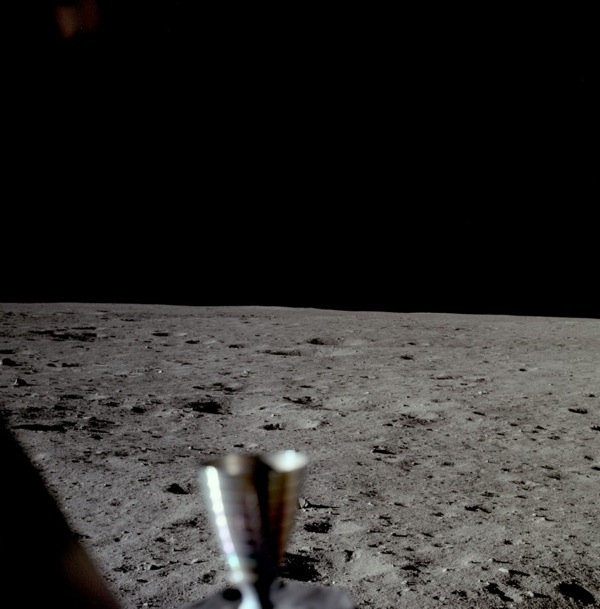
Neil got out first. After saying his (possibly) flubbed historic line, “That’s one small step for [a] man, one giant leap for Mankind,” he took this first picture while on the surface. That bag there is called a “jett bag.” Since weight is at such a premium, the astronauts throw out their trash. Yes, first picture, and you can see we’re already litterbugs. 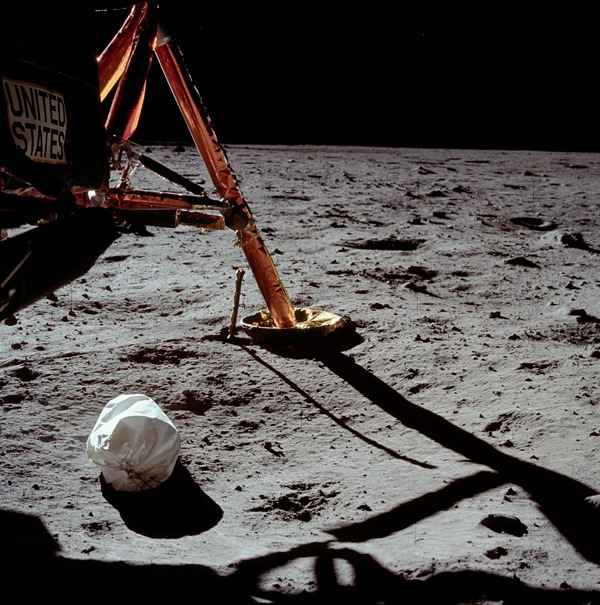
Neil took this picture of Buzz coming down the ladder after him. The surface of the Moon is very bright. It’s like one big bounce board. That’s why Buzz shows up so well in this picture, even though he’s in the LM’s shadow. That’s also why you don’t see any stars in Moon pictures. In order to take a picture of something bright (like the surface of the Moon,) you have to use a fast shutter speed and close the iris down on the camera. Otherwise everything would be washed out. Under those conditions, starlight is far too faint to show up. 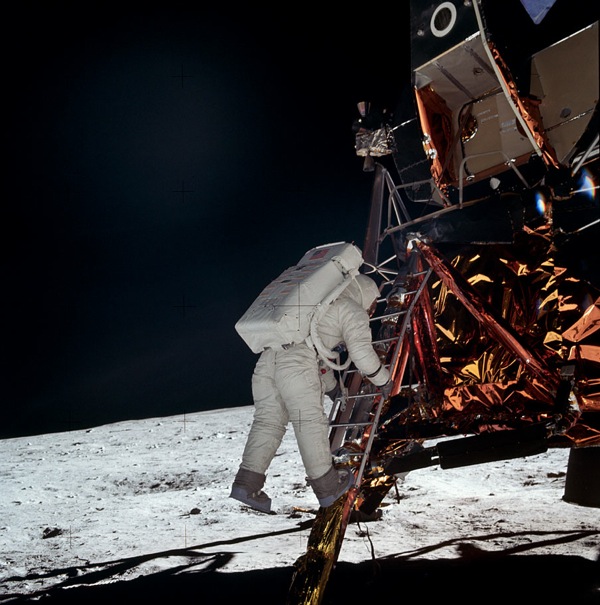
Here’s the plaque on the side of the lander. It says, “Here men from the planet Earth first set foot upon the Moon. July 1969, A.D. We came in peace for all Mankind.” 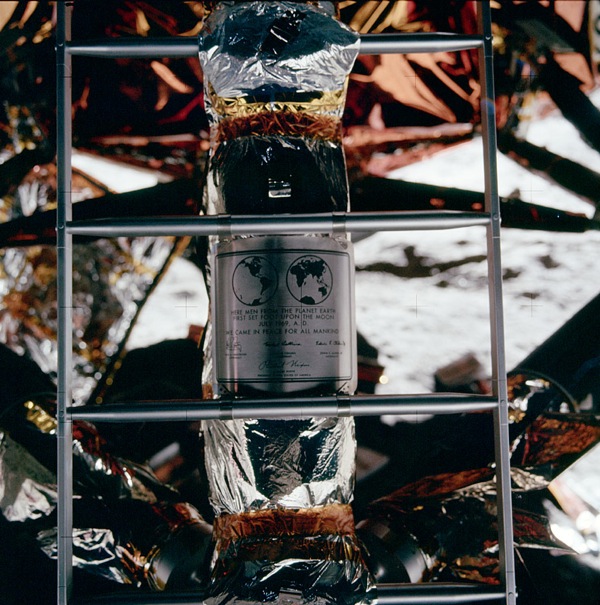
And then, kinda-sorta opposite to that, we have Buzz in front of the American flag. Why does it stand straight out like that, even though there’s no air (and therefore no wind) on the Moon? Well, they planned ahead. You can see the horizontal bar at the top of the flagpole. The flag is attached to it and it’s holding it out. It looks a little crumpled at the bottom because the flag is made of lightweight nylon fabric, and in that light gravity, it doesn’t even have enough weight to straighten itself out. Also, they didn’t pack an iron aboard Apollo 11. 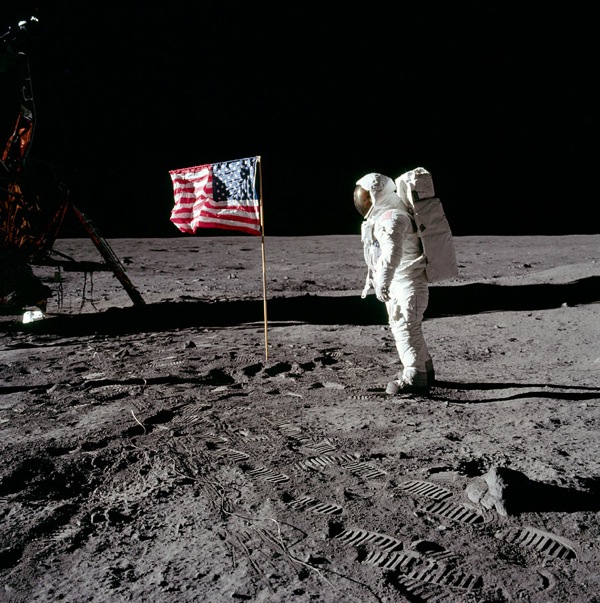
Here Buzz is checking the little cheat sheet attached to his suit’s wrist. This is one of the most iconic photos from Apollo 11. The version here is the original, a little tilted, not exactly framed, and with the LM leg visible. That gold pole sticking into the middle of the frame is a landing probe. There was one on the bottom of each LM leg, so they’d know exactly when they made contact with the surface. 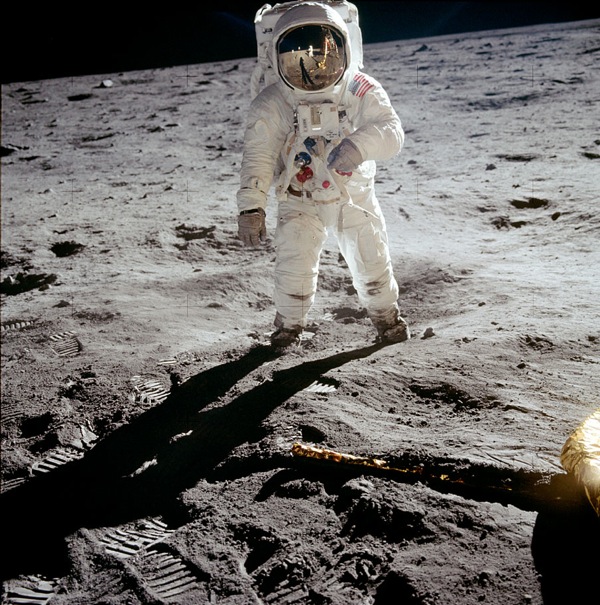
Just for fun, here’s a less iconic image from that day. Just like vacation photos, not every snap deserves a frame. 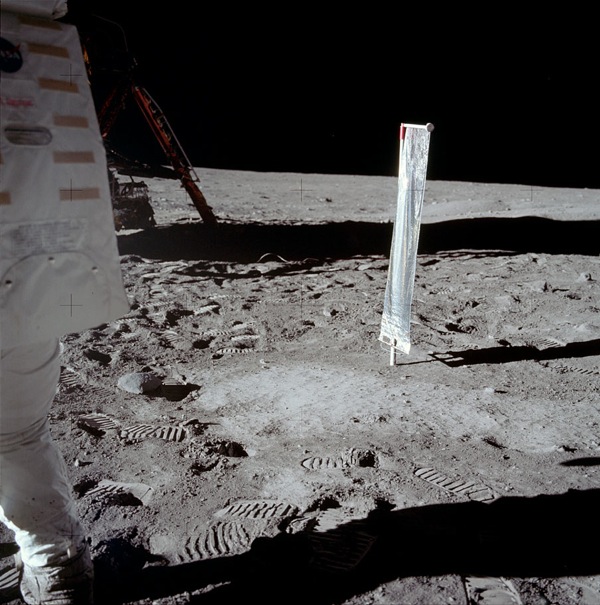
This shot gives you a sense of scale. That huge 363 foot tall Saturn V rocket was needed just to get this lightweight little ship to the Moon. But they’re going to leave the Moon with even less spaceship than they came with. Only the top part of the LM, the part not covered in foil, is going to blast off from the Moon. 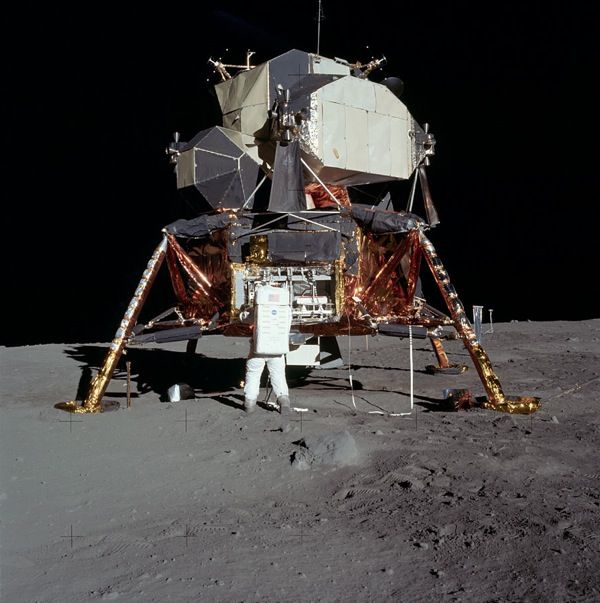
And that’s it. After 2 1/2 hours on the Moon, Neil and Buzz went back inside. On later Apollo flights, the astronauts would stay on the surface longer, and do multiple EVA’s. But this was the trial. This was to answer the question, “Can we even do this?” Here’s the face of the first man to walk on the Moon to give you an answer. 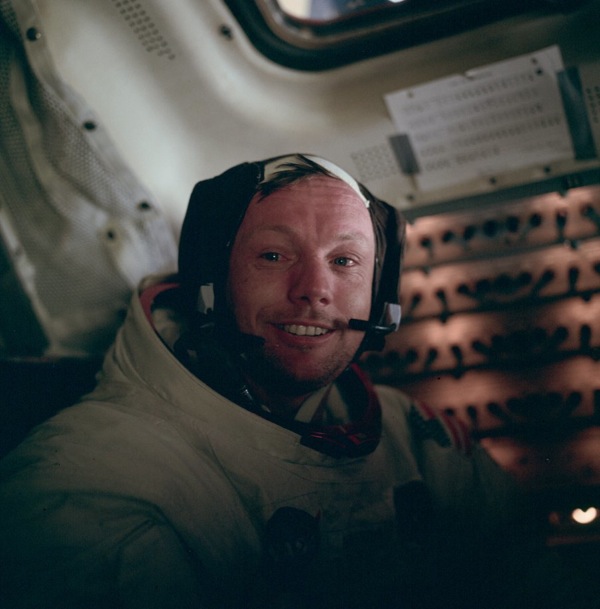
Neil and Buzz will stay on the surface for a few more hours, then they’ll start the long journey home. 